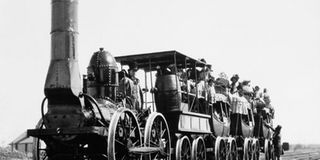Death of the Kampala-Bombo railway

On April 1, 1923, commercial operation of the Kampala-Kawempe railway commenced, transporting 3,700 tonnes of cotton by the end of the season. The two tractors did not perform to expectation and were replaced with bigger and more powerful ones.
What you need to know:
Back to 1926. Did you know that the famous Kalerwe Market on Gayaza Road was once a train stage and that it is where the suburb draws its name? That there was a train station in Gayaza Trading Centre and that at one time there was a railway from Kampala to Bombo via Mulago-Kawempe?
The construction of the Uganda Railway in the hinterland opened new private ventures of owning private railways, spreading out in other parts of the country feeding onto the main line. For the case of Uganda, two such railways were constructed. They included the Port Bell-Kampala (Mono Rail) which operated between 1909 and 1914 and the Kampala-Bombo (Road-Rail) that operated from 1923 to 1926.
The construction of the Kampala- Bombo road-rail was as a result of the consistent demand from the Uganda Chamber of Commerce and the Planter’s Association to the legislative council. A trial stretch was laid in 1920 from Kampala to Kawempe though the line from Kampala to Bombo did not operate commercially until April 1, 1923. The following year, a branch of the Kampala–Bombo line to Gayaza was opened.
This line was built mainly to facilitate the transportation of cotton from Bulemezi to Kampala, though there are speculations that it was built to ease transportation of military hardware to Bombo, hence it being known in some circles as the military railway.
Writing in the Uganda Journal of March 1963, W. J. Peal says the railway used the Loco-Tractor system invented by Frank Duntton of the South African Railways Motor Transport Department.
“The major feature of these tractors was their large driving wheels which operated outside the rails on the roadway,” Peal says, and goes ahead to explain that the people behind these Loco-Tractors “claimed that it was capable of handling heavy loads on considerably steeper gradients than could be achieved by conventional railway locomotives.”
After the demonstration on August 26, 1920, of how the Loco-Tractor was to work, the Uganda Herald newspaper praised the new transport venture, saying: “Thus in a simple way has come what will in all probability prove to be the solution of the transport problems in the protectorate for if the tractor will do only half what is claimed for the results will be far reaching indeed. To H.E (His Excellency) who originated the idea of this form of transport in the protectorate are due the thanks of the community.”
Developing the railway
While going for his annual leave in 1919, governor Sir Robert Coryndon left instructions with the then director of public works (the equivalent of minister of Works) Mr Claude Espeut to go ahead with experiments on the railway as soon as possible. Tracks were bought from the War Salvage Board for experimental purposes and a 300-yard (274-metre) track was laid near the Kampala station for the trials which were carried out in February 1920.
The acting governor reported back to the colonies office saying: “The trials should be discontinued as they will take a much longer time to bear fruits yet the country’s transport needs were immediate.”
He went on to say: “The cost of constructing another proposed road-rail from Mbale to Majanji would cover the cost of sufficient motor vans for the entire protectorate.”
The secretary to the colonies having got the report from the acting governor informed the Uganda Chamber of Commerce that such a venture was not going to be possible.
In his cable to the governor, on leave in London, dated March 10, 1920, the secretary told governor Coryndon that “no progress was being made with the Loco-tractor experiment since proofs of successful works would have to provide strong reasons for loan assistance for the development of internal transport”.
However, the governor insisted on having the project continue and he directed the director of public works to go ahead with the construction of a five-mile track, against the advice of all those concerned with the improvement of transport system in the country.
The Uganda Herald of March 26, 1920, voiced the concerns about the Uganda Development Commission about the commercial viability of having such railway transport in the country.
According to Peal, two people influenced the governor in disregarding the advice against the project. “First was Frank Worthington, the governor’s brother in-law, acting on behalf of road-rail Company in Uganda, who in September 1920 had applied to have his company construct the Mbale-Majanji railroad. The other was Major E. A. T. Dutton, the secretary to the governor and a relative to Frank Dutton, the inventor of the railway system,” Peal says.
By the time of Coryndon’s return from leave, the track from Kampala to Kawempe was complete and the trial run was done in August 1920. The experiment locomotive was a converted Ford Box motorcar from which the front axle and wheels had been removed to fit a rail bogie. The experiment journey from Kampala to Kawempe was covered in 12 minutes with a cotton cargo of three tons.
Commenting on the experiment, The Uganda Herald of September 24, 1920, reported: “Perhaps more important, it convinced the members of the Chamber of Commerce of the potential of the road-rail.”
In the Chamber of Commerce’s next sitting after the experiment from Kampala to Kawempe, it was resolved that “the chamber approves of the decision of the government to order a further 50 miles to be laid along Bombo Road. The chamber would welcome the opportunity of giving its opinion on the most suitable routes for any extension to be placed”.
Sir Coryndon’s interest in the railway became a point of discussion in all his speeches after the experiment. During his speech at the opening of the first Uganda Legislative Council as president in March 1921, he talked of how other countries as far as central Europe, India, and Rhodesia (Zimbabwe) were interested in learning from the Uganda experiment.
One of the main attractions of the railway was how it was laid along the edge of the existing roads, for it to serve the public better by going through existing towns and villages. Some sections of the public were disappointment when government decided to reroute the Bombo railway along the Kitante valley from South Street because some sections of the drainage on Bombo road were badly affected during the rainy season.
Another reason was that it was better for the railway not to run through the centre of Kampala in order to avoid traffic distraction and the necessity to maintain level crossings.
Two tractors imported
Upon completion of the construction of the track, two tractors were imported in mid-1922, however, in a joint report by the directors of public works and that of transport -- G.N.
Loggin and Major R.B. Hill respectively -- titled the Stronach-Dutton system of road rail transport as in operation in the Uganda protectorate, they stated: “As these two tractors were the first to be constructed much trouble and expense had been incurred locally in remedying the defects in both engines and chassis.”
In February 1923, the Uganda Chamber of Commerce complained of the slow rate at which progress in the opening of the track was taking ahead of the year’s cotton harvest season. However, on April 1, 1923, commercial operation of the track commenced, transporting 3,700 tons of cotton by the end of the season, generating £1,812 against an expenditure of £2,341.
The two tractors did not perform to expectation and had to be replaced. The replacements arrived in May 1924. On their arrival, the Uganda Herald, which had now become critical of the project which they had initially praised, reported in its May 16 edition that: “Such huge things –so very powerful and very heavy that they will probably necessitate the relaying of the track wheel ways.”
“Wait and see or weight and sink,” it concluded in a sarcastic way.
The new tractors faced a lot of difficulty in operating as they were run using wood fuel, but after intervention from the foreman from the Busoga Railway (another private company running a railway line there), they started performing to expectations.
The railway’s challenge was the 1924 season when it had more than 100 tonnes of cotton to transport from Bombo to Kampala daily but could only manage 15 tonnes per trip, making only 46 trips in the entire cotton peak season between March and May.
The tone of a letter from the director of transport to the chief secretary back in London summed up the disappointment of the protectorate government in the railway services: “Again the movement of cotton by the rail-road from Bombo is at a standstill.”
With that poor performance, the Chamber of Commerce and the Ginner’s Association complained in June 1924, leading to the creation of a commission of inquiry headed by Maj Rhodes, the chief engineer of the Uganda railway.
The commission was to find the causes of the failures of the roadway system. Rhodes’s commission concluded that the tractors would have been more efficient using coal than wood or paraffin, and that there was need for improvement in the maintenance. He also suggested that the system should be kept in service than closing it down.
In 1925, the Uganda railway recorded its highest transport tonnage, but the following year it nosedived to its lowest. The fall was due to handling procedures at Kampala station, forcing ginners to resort to sending their cotton direct to Port Bell by motor vans than the railway.
In November 1926, it was realised that the railway was a bad proposition and that it was not a profitable venture. During the December Legislative Council meeting, the acting governor reported to the council that the traffic on the railway was disappointing mainly because of competition from the native-owned lorries and announced that the system was to be closed on December 31, 1926.
About Train sheds
Sheds big enough to accommodate a train were built at Kampala, Bombo and Gayaza, each measuring 116ft by 25ft. The tracks passed through the shed at one side leaving a working platform for offloading. At Kawempe and Mulago stations there was a provision for a turnaround.
According the Sir Albert Cook’s book Uganda Memories, he says: “The shed at Gayaza was pulled down in 1928 and re-erected at Ndejje as part of the nurses training school being started by lady A. R. Cook.”
The place where this nurse training school once stood is the present day Nalinya Lwantale School in Ndejje.



